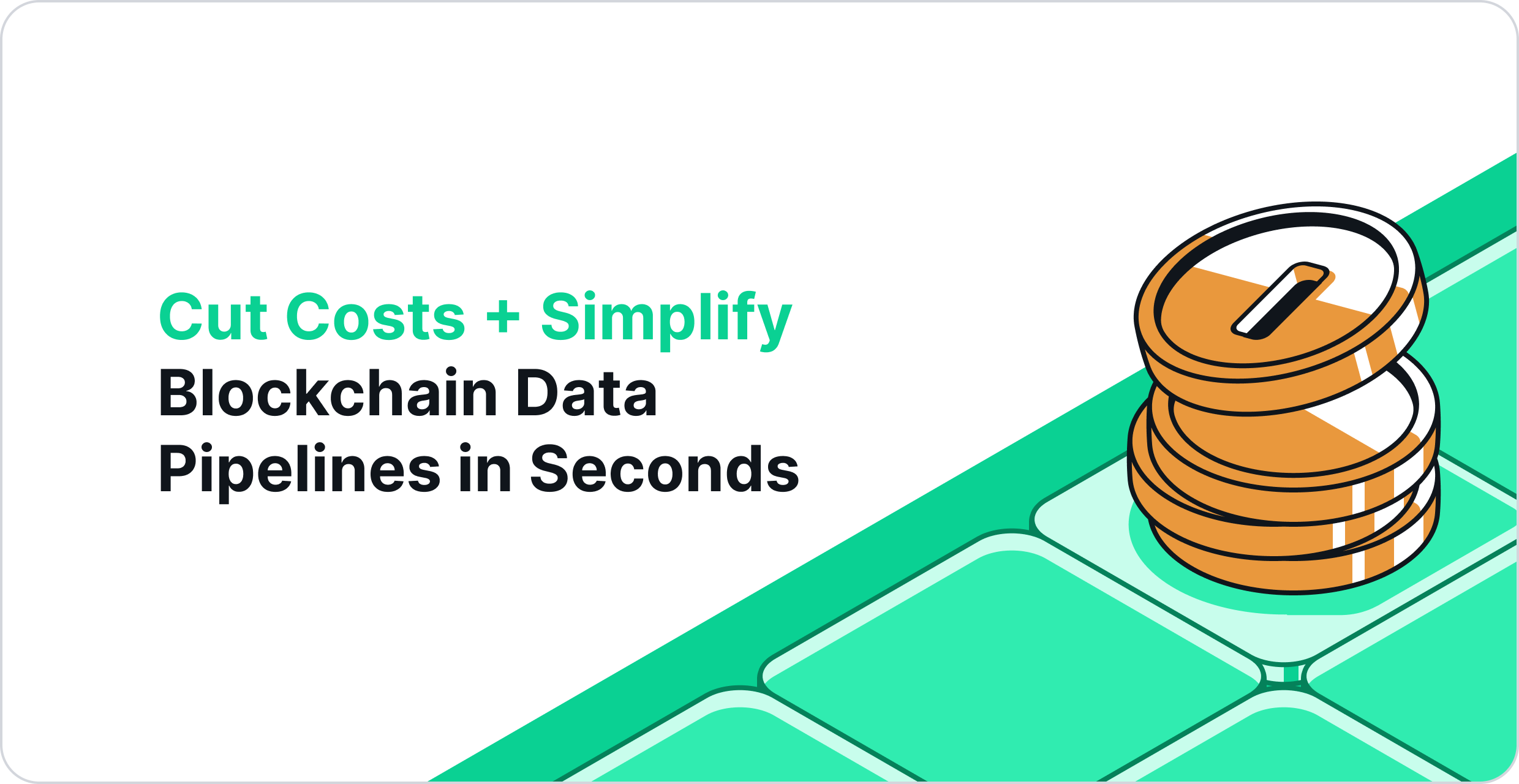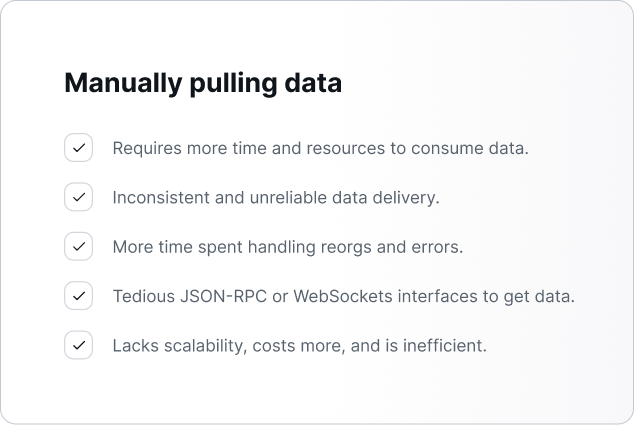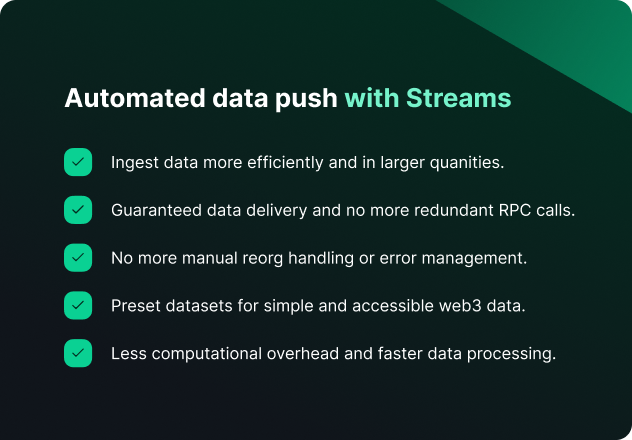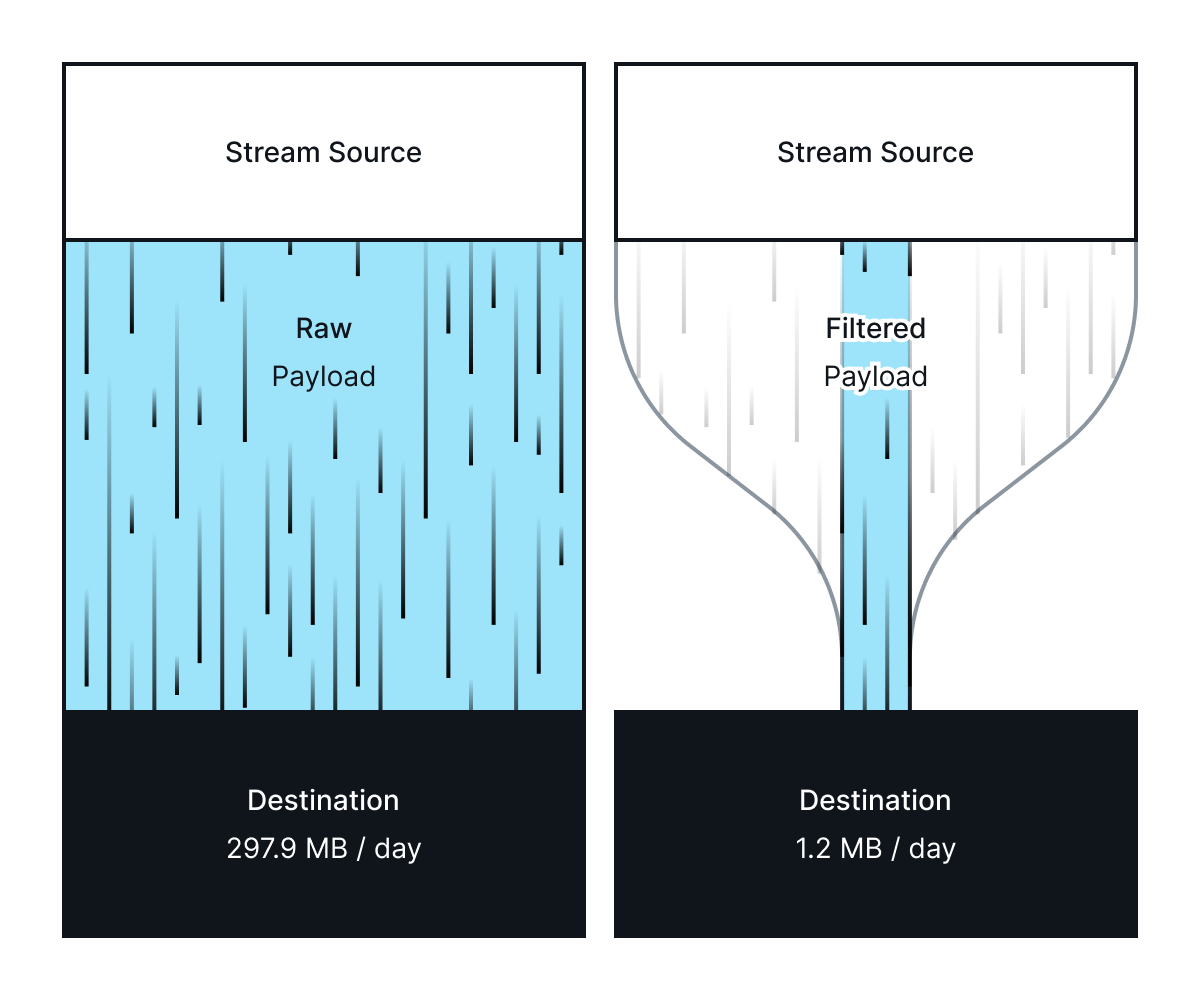Cut Costs + Simplify Blockchain Data Pipelines in Seconds; Here's How
Discover the power of real-time blockchain data streaming for instant insights. Learn how it works, its benefits, and key use cases.

In the fast-paced world of decentralized applications (dApps), real-time data processing is essential.
Whether it's managing millions of transactions daily on an exchange or ensuring timely reporting for regulatory compliance, having access to real-time blockchain data is crucial.
Blockchain data streaming makes this possible by continuously transmitting blockchain data to various endpoints for analysis, storage, and utilization. However, developers often face challenges like data inconsistencies and operational complexities when dealing with real-time blockchain data.
In previous blogs, we covered the basics of blockchain ETL and how to accelerate your products with streaming indexed data.
Today, we’ll explore the mechanics of real-time blockchain data, the common challenges, and how QuickNode’s ETL solutions can simplify the process.
The Mechanics of Real-time Blockchain Data Processing
Real-time blockchain data processing involves handling data as soon as it’s available on the blockchain. This ensures dApps and services remain in sync with onchain data, enabling functionalities like real-time portfolio tracking. Here's how it works:
Blockchain Nodes
Nodes are the backbone of the blockchain, maintaining copies of the entire blockchain, validating transactions, and ensuring network synchronization. They also enable direct ingestion of blockchain data as it's produced. However, running a node requires significant resources and effort.
QuickNode simplifies node management, providing reliable, scalable access to blockchain networks without the need to maintain personal infrastructure.
Data Ingestion
Data ingestion involves capturing new blockchain data, including transactions and block updates, from the network. This keeps applications synchronized with the latest onchain state, enabling real-time functionalities like portfolio tracking or monitoring smart contract executions.
Event Monitoring
Event monitoring tracks specific activities on the blockchain, such as transactions and smart contract executions. Continuously querying the blockchain for new events can be resource-intensive, but tools like Streams by QuickNode simplify this process.
Event Processing
Event processing interprets and acts on detected blockchain events, enabling real-time data processing by validating events and executing appropriate business logic. For example, Streams can trigger actions like rebalancing a portfolio or executing a trade based on predefined events.
Indexing and Querying
Blockchains generate vast amounts of data. Indexing and querying tools like QuickNode help retrieve and organize this data, making it easier for dApps to access relevant information without scanning the entire blockchain database.
Use Cases of Blockchain Data Streaming
Real-time blockchain data streaming has several valuable applications:
Regulatory Compliance
Financial institutions must monitor transactions in real-time to comply with regulations like AML (Anti-Money Laundering) and KYC (Know Your Customer). Blockchain data streaming ensures that all transactions are instantly available for analysis and reporting.
Predictive Blockchain Maintenance
Developers can use blockchain data to predict potential network issues before they occur. By analyzing historical data and identifying patterns, developers can implement predictive maintenance strategies, minimizing downtime and optimizing blockchain application performance.
Onchain Incentives
Developers can analyze blockchain data to design and optimize tokenomics and incentive structures. By understanding user interactions with tokens and rewards, developers can create more effective incentive schemes, driving user participation and engagement.
User Personalization
Blockchain data analytics allows developers to create personalized user experiences by analyzing user interactions and preferences. For instance, they can offer customized DeFi investment strategies based on transaction history or personalized NFT art suggestions based on buying patterns.
Challenges with Data Streaming in Blockchain Applications
Data streaming in blockchain applications comes with several challenges:
- Operational and Cost Challenges: Managing infrastructure for blockchain data ingestion requires scaling resources in response to chain dynamics.
- Data Inconsistency: Ensuring real-time data consistency is difficult due to varying finality times and blockchain reorganizations.
- Historical Data Handling: Managing large batches of historical data requires precise configuration and can be technically demanding.

How Blockchain ETL Simplifies Real-Time Data Streaming
Blockchain ETL (Extract, Transform, Load) solutions streamline the handling of blockchain data from collection to analysis. Here’s a step-by-step breakdown:
Extract
Connect to blockchain nodes or use API providers to listen to events like block creation and transaction confirmations.
Transform
Parse raw blockchain data, filter specific transactions, and aggregate data to meet application needs.
Load
Store the transformed data in databases, data lakes, or other storage solutions for efficient querying and analysis.
These steps simplify the complexities of blockchain data, providing a plug-and-play method for data streaming.
Implementing Blockchain Data Streams with QuickNode
QuickNode’s Streams is designed to further address the challenges of blockchain ETL and streamline your data pipelines by supporting data integration from multiple blockchain networks in real-time.

Streams offer efficient blockchain data management with features like:
- Guaranteed Data Delivery: Built to be re-org proof, Streams ensures delivery of blockchain data to users in a sequential and continuous manner, eliminating manual querying and reducing engineering time.
- Data Consistency: Handles varying finality times and blockchain reorganizations to ensure data consistency.
- Historical Data Handling: Simplifies historical data analysis with configurable large data batches and precise date ranges, and has access to a variety of datasets, including traces.
- Effortless Integration: Seamlessly integrate Streams into your projects with just a few clicks. Set up Streams with the blockchain networks and data sources of your choosing.
- Only Pay For What You Use: With the new Filters for Streams, you can optimize costs by ensuring you only pay for the data you truly need.

Streamlining Real-Time Blockchain Data Processing with QuickNode
Real-time data processing is vital for dApps, enabling them to manage transactions, ensure compliance, and provide real-time analytics. Traditional data processing systems struggle with blockchain data due to its decentralized, high-volume nature.
Streams, with powerful features such as Filters, offer a comprehensive solution, providing exactly-once delivery, automatic scaling, detailed transaction insights, and customizable data payloads.
FAQs
How do I connect blockchain data to my existing traditional databases?
Streams is a perfect way to facilitate your entire blockchain ETL pipeline right out of the box. Streams offer seamless real-time ETL capabilities, ensuring consistent data flow and eliminating extensive infrastructure management.
How much does it cost to set up and maintain a blockchain ETL pipeline?
Costs vary based on data complexity, blockchain network scale, and business requirements. When using Streams, your data transfer cost is determined by which plan your account currently uses—higher plans pay less per GB! You can also save costs by using Filters for Streams, which allow you to precisely control the data you receive, ensuring you only pay for and process the data you need.
How can I ensure compliance and security when processing blockchain data?
Streams provide robust encryption and access controls, ensuring compliance with regulations like GDPR and AML and facilitating timely reporting and auditing.
Real-time blockchain data streaming is key to unlocking powerful insights and functionalities in the decentralized world. With QuickNode’s solutions, you can simplify and streamline your data processing needs, ensuring your dApps run smoothly and efficiently.
How can I get started with Streams?
Streams are now available on your QuickNode dashboard for accounts with the Build plan and higher. We have in-depth documentation on setting up your first stream and thorough guides, such as using Filters with Streams. Get started with Streams today and discover their impact on your project.
A Complete Platform for Blockchain Data and ETL Expertise
Functions, also launching soon, can be combined with Streams to radically solve any blockchain data need. Common programming languages—including Javascript, Python, Go, or Ruby—can efficiently transform payloads from Streams, enrich them with contract data by calling QuickNode endpoints, and much more.
Building upon an already robust blockchain data product portfolio, including Core RPC, adding Streams and Functions ensures QuickNode is the trusted solution provider for all your ETL needs.

About QuickNode
QuickNode is building infrastructure to support the future of Web3. Since 2017, we've worked with hundreds of developers and companies, helping scale dApps and providing high-performance access to 30+ blockchains. Subscribe to our newsletter for more content like this, and stay in the loop with what's happening in web3!





